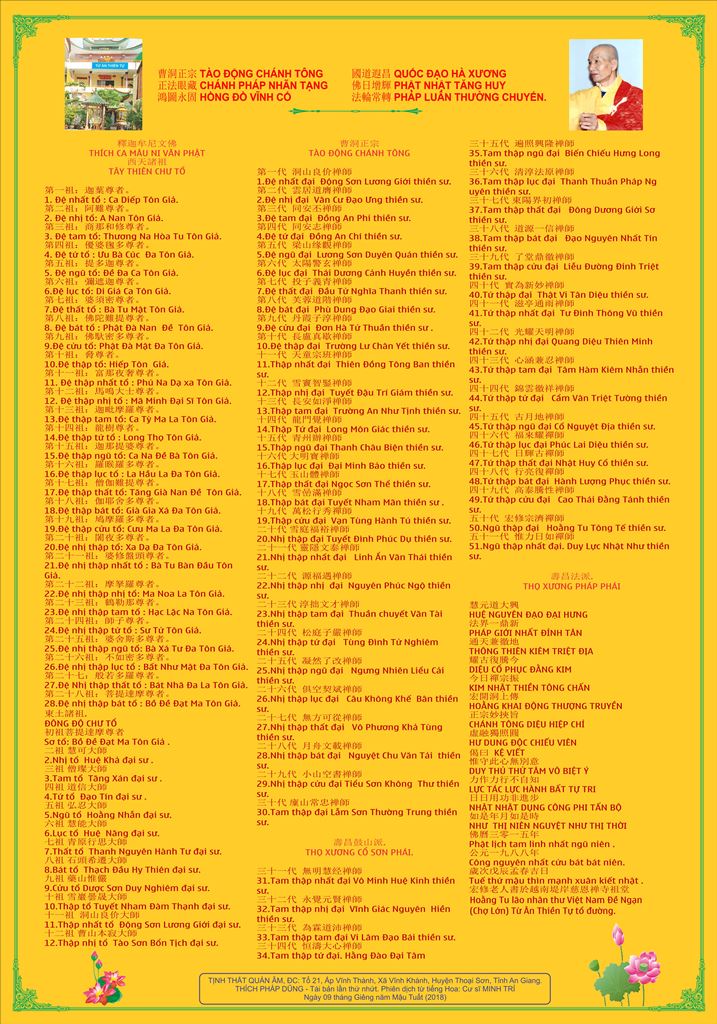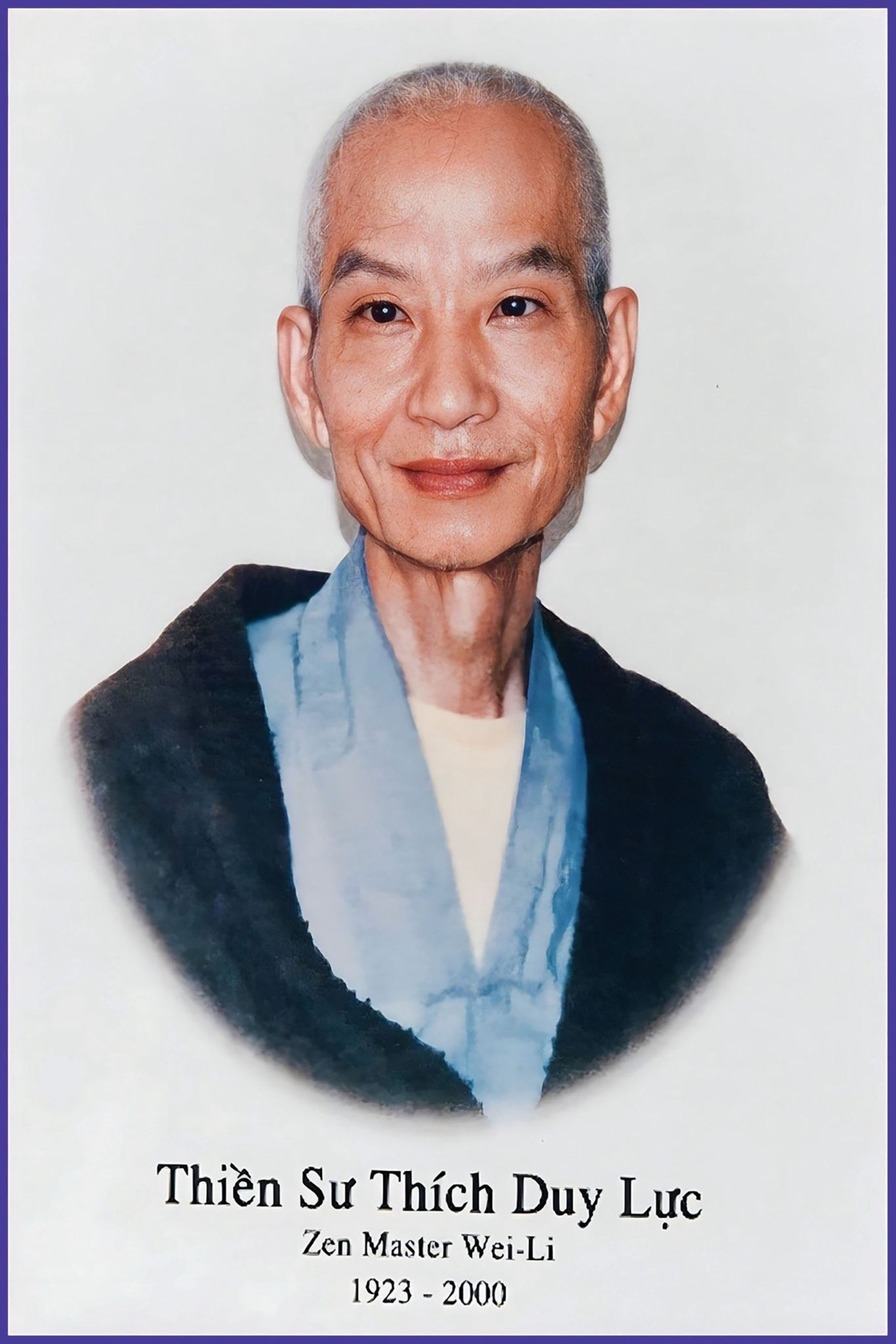Biography
INTRODUCTION
Biography
Born on May 5, 1923 in China, and passed away on January 7, 2000 in the United States, he left a dharma heritage that has influenced and thrived in Vietnam and in many other countries. He had the birth name La Du and another dharma name Giac Khai.
When he finished elementary school at 16, his father took him to immigrate to Can Tho, Vietnam, where he studied by himself and 10 years later obtained a teacher degree in teaching Chinese. From 1948, he was invited to teach for ten years at several elementary schools – first at a school in Ta Keo Province, Cambodia, then at Khai Tri Elementary School in Can Tho and at Cai Von Elementary School in Vinh Long, Vietnam.
In 1958, after obtaining an Oriental medicine degree, he was invited to work as a doctor of traditional medicine and provide free medical services to poor patients at the Te Nguon Duong Ca Mau clinic and the Minh Nguyet Cu Si Lam, a Buddhist association in Can Tho, for eight years. When he found in the library of Cu Si Lam the Kinh Tucm Tang, a set of 150 books on Buddhism, he tried to read all them.
One year later, he finished reading just seven books; hence he decided that he would read only the Zen books. At the time, he was also learning the Patriarch Zen from Dharma Master Dieu Duyen, who had many years of following closely Zen Masters Hu Van and Lai Qua. Dieu Duyen later died in 1976 at the Thao Duong Temple, Vietnam.
In February 8, 1973, he was received by Venerable Hoang Tu into the Tu An Temple, Cho Lon, to live as a novice monk.
In May 1974, he received the full monastic codes of a Bhiksu in an ordination ceremony at the Cuc Lac Temple, Malaysia.
Since then, he meditated tirelessly on the huatou “Who I was before the existence of heaven and earth?” for many years.
One day, while reading the book “Discourse on Madhyamika,” he saw the sentence “Because of emptiness, all things are done,” and suddenly understood the meaning of “From emptiness, the activity appears.”
He then understood that the emptiness was born from the great wisdom; that, according to the Shurangama Sutra (Shoulengyan Jing), countless worldly countries were born from the emptiness just like a mountain of bubbles arised from the ocean; that the Sixth Patriarch’s saying “Clinging to nothing must be the core of your thinking” had the same direction as Vimalakirti’s saying “From the non-abiding base, establish all things”; that the non-abiding meant the nature of emptiness; that the True Suchness was originally emptiness, but it flowed out all activity; that the nature and activity of all Buddhas were the same as those of sentient beings, spreading all over time and space; and that every sentient being, unknowingly, was using the activity of their Buddha nature.
On April 2, 1977, obeying the order of his patron master, Venerable Hoang Tu, Zen Master Duy Luc started teaching the Patriarch Zen at Tu An Temple, Ho Chi Minh City.
Within 2 years, thousands from the four groups of Buddhists came to him to learn; it was estimated that over 4,000 Buddhists practiced Zen under his guidance, and every Zen retreat had average over 300 participants.
In February 1989, he immigrated to the U.S., and founded Tu An Zen Temple in Orange County, California. Practitioners coming to study Zen under his guidance were Westerners and Asians, in which mostly were Vietnamese and Chinese.
He was also invited to teach the Patriarch Zen in other Zen centers in America, and in many other countries – frequently at Chanh Giac Temple in Toronto, Canada; Dai Bi Temple in Taiwan; Quan Am Temple in Brisbane, Australia; and in Hong Kong.
Especially, Zen Master Duy Luc responded warmly to any invitation from the temples in Vietnam when possible.
He conducted many Zen retreats in Ho Chi Minh City, mostly at Tu An Temple in District 5, Hung Phuoc Temple in District 3, Phap Thanh Temple and Sung Duc Temple in District 6, and Hue Quang Temple in Tan Binh District; in the Ba Ria Vung Tau Province, mostly at Dai Tong Lam Temple and Thien Hoa Nunnery; and in many temples in the provinces of Long An, Soc Trang, Tay Ninh, Khanh Hoa and Binh Dinh.
In 1996, Zen Master Duy Luc founded a Zen farm in Cu Chi, Saigon, where he and his students grew organic vegetables (i.e., without fertilizer and pesticide).
In 1998, he was invited by the Vietnam Buddhist Church (VBC) to be a member of the Central Buddhist Education Committee.
He accepted the VBC’s request, and taught at the short-term expanded education courses in Binh Dinh, where learners came from the central provinces, and at the second central office of the VBC, where learners came from Saigon and from the southern and eastern provinces.
In 1999, he founded a medical clinic in Long Thanh District, Dong Nai Province, gave free treatment and medicine to patients, and circumstantially expounded the Zen teachings.
RECORDS:
He wrote, translated from Chinese into Vietnamese, and penned his own commentaries on dozens of Buddhist scriptures and Zen classics. The circulation of his books, mostly in Vietnamese and some in Chinese, was estimated at about tens of thousand copies in print in Vietnam.
The books authored by Zen Master Duy Luc included:
- Góp Nhặt Lời Phật Tổ và Thánh Hiền (A Collection of the Words of Buddha and Patriarchs),
- Công An Của Phật Thích Ca & Tổ Đạt Ma (Koans from Buddha and Bodhidharma),
- Phật pháp với Thiền Tông (Buddhist Teachings and Zen),
- Đường Lối Tham Tổ Sư Thiền (An Approach to Patriarch Zen),
- Danh Từ Thiền Học (A Dictionary of Zen),
- Vũ Trụ Quan Thế Kỷ 21 (A Worldview for the 21th Century),
- Yếu Chỉ Trung Quán Luận (The Core of Madhyamaka),
- Yếu Chỉ Phật Pháp (The Core of Buddhist Teachings)…
The books translated and commented by Zen Master Duy Luc included:
- Kinh Lăng Nghiêm (Shurangama Sutra),
- Kinh Lăng Già (Lankavatara Sutra),
- Kinh Pháp Bảo Đàn (The Platform Sutra),
- Kinh Viên Giác (Perfect Enlightenment Sutra),
- Kinh Duy Ma Cật (Vimalakirti Sutra),
- Đại Huệ Ngữ Lục (The Record of Dai Hue),
- Tham Thiền Cảnh Ngữ (Warning Words on Practicing Zen, authored by Venerable Bác Sơn),
- Thiền Thất Khai Thị Lục (The Record of Guiding Words in Zen Retreats, authored by Zen Master Lai Quả),
- Bá Trượng Quảng Lục và Ngữ Lục (The Expanded Record and Words of Ba Truong),
- Truyền Tâm Pháp Yếu (The Essential Teachings of Transmitting the Mind),
- Trung Phong Pháp Ngữ (The Record of Trung Phong),
- Cội Nguồn Truyền Thừa (The Line of Dharma Transmission),
- Chư Kinh Tập Yếu (The Essential Teachings from a Collection of Sutras),
- Tín Tâm Minh Tịch Nghĩa GiảI (Expounding The Quiet Meanings of “Verses on the Faith in Mind”).
1:
📖 An Approach to Patriarch Zen
📖 Warning Words on Practicing Zen, authored by Venerable Bác Sơn
📖 The Expanded Record and Words of Ba Truong
📖 The Expanded Record and Words of Ba Truong
📖 The Essential Teachings of Transmitting the Mind
📖 The Line of Dharma Transmission
📖 Expounding The Quiet Meanings of “Verses on the Faith in Mind”
2:
📖 Koans from Buddha and Bodhidharma
📖 An Approach to Patriarch Zen
📖 A Worldview for the 21th Century
📖 The Core of Madhyamaka”, The Core of Buddhist Teachings
📖 The Core of Buddhist Teachings
📖 Góp Nhặt Lời Phật Tổ & Thánh Hiền
DHARMA TRANSMISSION POEM:
TÂM NGUYÊN QUẢNG LỤC,
BỔN GIÁC XƯƠNG LONG.
NĂNG NHÂN THÁNH QUẢ,
THƯỜNG DIỄN KHOAN HOẰNG.
DUY TRUYỀN PHÁP ẤN,
CHỨNG NGỘ HỘI DUNG.
KIÊN TRÌ GIỚI ĐỊNH,
VĨNH KẾ TỔ TÔNG.
RECORDS OF LINEAGE ORIGIN
His original source was written by the old monk Hoang Tu in the spring of Mau Thin year 1988, PL 3015 at the To Duong of Tu An Thien Tu (440 Hong Bang, Ward 16, District 11, Saigon - South Vietnam):


🧷 ORIGINAL IMAGE FILE (Vietnamese translation - Minh Tri layman)
According to the above, He belongs to the Dharma life 88 since the first patriarch Maha Kassapa
- sect
- Caodong (Soto)

